Gallery of additional pictures
Gallery 1: C 1910 - Novembert 1962
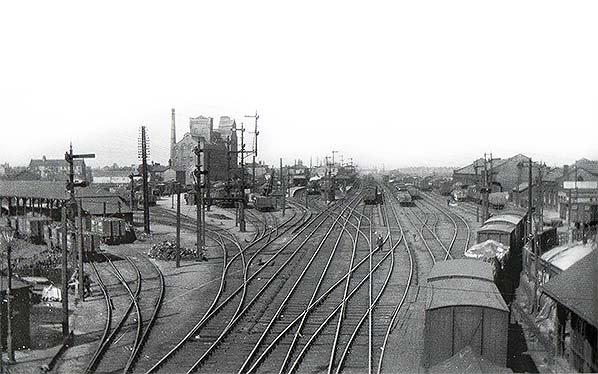 Cambridge South looking north from Hills Road bridge c1910. This is one of the few photographs showing the original Cambridge South signal box, centre distance. The, then, short length of platforms 1 and 2 is also evident. South box was demolished in 1926 and a new box erected about where the nearest carriage stands on the road directly ahead of the camera. At the same time, Hills Road Junction box, just visible on the right, was abolished and removed. The LNER greatly altered much of the track layout seen above and in particular the goods roads on the right which were something of a bottleneck. It was to be some years before the up relief road was installed south of Hills Road; 1922 in fact, for the Royal Show of that year. On the left is Messrs Coote & Warren's coal staithes. The Great Northern goods yard is out of view to the left. Foster's Mill stands dominant as ever. Centre distance, right, is the GER goods shed while the GNR goods shed and engine shed are further right and off the picture
Cambridge South looking north from Hills Road bridge c1910. This is one of the few photographs showing the original Cambridge South signal box, centre distance. The, then, short length of platforms 1 and 2 is also evident. South box was demolished in 1926 and a new box erected about where the nearest carriage stands on the road directly ahead of the camera. At the same time, Hills Road Junction box, just visible on the right, was abolished and removed. The LNER greatly altered much of the track layout seen above and in particular the goods roads on the right which were something of a bottleneck. It was to be some years before the up relief road was installed south of Hills Road; 1922 in fact, for the Royal Show of that year. On the left is Messrs Coote & Warren's coal staithes. The Great Northern goods yard is out of view to the left. Foster's Mill stands dominant as ever. Centre distance, right, is the GER goods shed while the GNR goods shed and engine shed are further right and off the picture
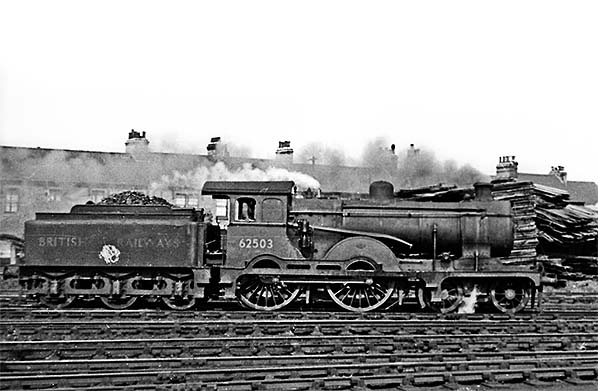 A shabby D15 4-4-0 sits outside Cambridge shed in August 1949 with the houses of Devonshire Road in the background. No.62503 began life as a member of GER Class S46, then Class D14 under the LNER and had undergone a number of modifications during the prewar years to end up as a D15. She is seen paired with a water-cart tender, as were a few of the class, and this gave the ensemble a slightly odd appearance. The white mark in the middle of the tender is thought to be a flaw on the negative. When photographed, No.62503 was a Bury St Edmunds locomotive and she was withdrawn from that shed in February 1951. Some of the water-cart tenders lived on and could be seen paired with E4 and J15 class locomotives.
A shabby D15 4-4-0 sits outside Cambridge shed in August 1949 with the houses of Devonshire Road in the background. No.62503 began life as a member of GER Class S46, then Class D14 under the LNER and had undergone a number of modifications during the prewar years to end up as a D15. She is seen paired with a water-cart tender, as were a few of the class, and this gave the ensemble a slightly odd appearance. The white mark in the middle of the tender is thought to be a flaw on the negative. When photographed, No.62503 was a Bury St Edmunds locomotive and she was withdrawn from that shed in February 1951. Some of the water-cart tenders lived on and could be seen paired with E4 and J15 class locomotives.
Photo by Ben Brooksbank
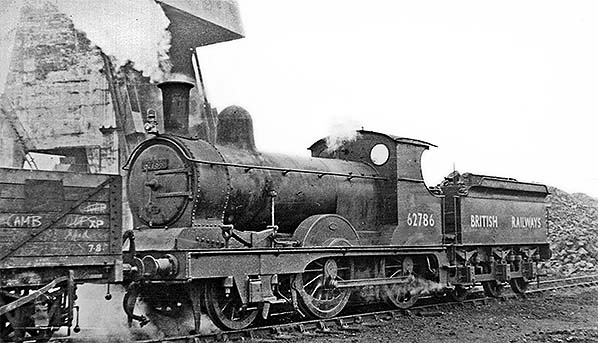 Class E4 No.62786 beside the coaling tower at Cambridge in February 1951. Note the XP rated open wagon; these wagons were common but the XP rating was normally associated with vans. Vehicles so rated had different bearings, were fitted with screw couplings and had either train brakes or through piping. This allowed them to travel at higher speeds than 'ordinary' wagons and be coupled to passenger trains if necessary. XP vans were once a common sight coupled to branch passenger trains, including DMUs. 62786 was withdrawn in July 1956, having been in service for 61 years. The tender lettering was BR's first, and interim, corporate identity. The reason the railways were nationalised was their rundown condition following WWII and although, it must be said, the railways and their staff played a very major part in the war effort, nationalisation tended to sneered at by the public. This attitude, which worsened as car ownership increased, was very insulting to the people who kept the railways going during the war and especially to those who lost their lives in doing so. Nevertheless, the wording BRITISH RAILWAYS did give a sense of belonging if not solidarity at a time when Britain was still struggling through the aftermath of war.
Class E4 No.62786 beside the coaling tower at Cambridge in February 1951. Note the XP rated open wagon; these wagons were common but the XP rating was normally associated with vans. Vehicles so rated had different bearings, were fitted with screw couplings and had either train brakes or through piping. This allowed them to travel at higher speeds than 'ordinary' wagons and be coupled to passenger trains if necessary. XP vans were once a common sight coupled to branch passenger trains, including DMUs. 62786 was withdrawn in July 1956, having been in service for 61 years. The tender lettering was BR's first, and interim, corporate identity. The reason the railways were nationalised was their rundown condition following WWII and although, it must be said, the railways and their staff played a very major part in the war effort, nationalisation tended to sneered at by the public. This attitude, which worsened as car ownership increased, was very insulting to the people who kept the railways going during the war and especially to those who lost their lives in doing so. Nevertheless, the wording BRITISH RAILWAYS did give a sense of belonging if not solidarity at a time when Britain was still struggling through the aftermath of war.
Photo by Ben Brooksbank
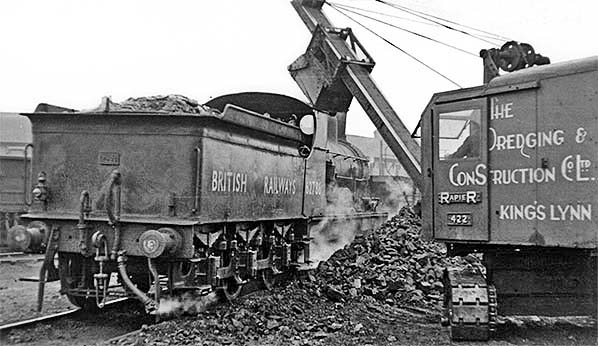 Here is 62786 again, same date, same place. She is apparently being coaled by a dredger, presumably hired-in due to the coaling tower being out of action for some reason. The Dredging & Construction Co.Ltd survived as an entity, still based at King's Lynn, until recently (this being written in 2015) and certainly long enough to have their own website. After a relocation to Gateshead, they were apparently swallowed up by Visser & Smit Hanab, a Dutch firm with, at the time of writing, a UK base at Kettering. In 2010 the former DCC premises at St Peter's Road, West Lynn, had been cleared and the land derelict but the semi-ornate gates survived still bearing the 'D 1949 C' inscription. Note the three pipes on the tender of No.62786; steam heat (bottom), air (upper left) and vacuum (upper right). Her Westinghouse pump is just visible in front of the cab and she was fitted with a vacuum ejector c1930 by the LNER. The GER was a Westinghouse railway and the addition of vacuum ejectors allowed GER locomotives to work other companies rolling stock. The rectangular plate on the rear of the tender is the tender worksplate. These plates gave details of where and when the tender was built and its water capacity, plus the tender number. Tenders were given their own series of works numbers which bore no relation to that of the locomotive to which it was attached.
Here is 62786 again, same date, same place. She is apparently being coaled by a dredger, presumably hired-in due to the coaling tower being out of action for some reason. The Dredging & Construction Co.Ltd survived as an entity, still based at King's Lynn, until recently (this being written in 2015) and certainly long enough to have their own website. After a relocation to Gateshead, they were apparently swallowed up by Visser & Smit Hanab, a Dutch firm with, at the time of writing, a UK base at Kettering. In 2010 the former DCC premises at St Peter's Road, West Lynn, had been cleared and the land derelict but the semi-ornate gates survived still bearing the 'D 1949 C' inscription. Note the three pipes on the tender of No.62786; steam heat (bottom), air (upper left) and vacuum (upper right). Her Westinghouse pump is just visible in front of the cab and she was fitted with a vacuum ejector c1930 by the LNER. The GER was a Westinghouse railway and the addition of vacuum ejectors allowed GER locomotives to work other companies rolling stock. The rectangular plate on the rear of the tender is the tender worksplate. These plates gave details of where and when the tender was built and its water capacity, plus the tender number. Tenders were given their own series of works numbers which bore no relation to that of the locomotive to which it was attached.
Photo by Ben Brooksbank
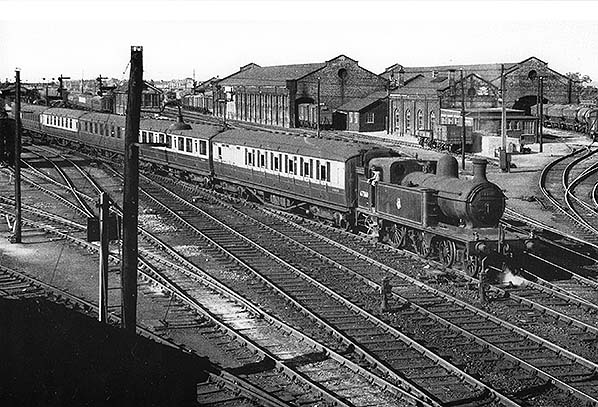 On 30 June 1951 Class C12 4-4-2T No.67360 was gainfully employed as Cambridge south pilot. Very obviously of GNR origin, 67360 was the first of the second batch which was intended for London suburban services (the first batch operated in Yorkshire) and originally had condensing gear for operating over the Metropolitan Widened Lines. Found to be unsuited to London suburban work as train weights increased, many later found themselves pottering around rural areas, in Lincolnshire for example. Cambridge shed had four of the class, primarily for use on the Saffron Walden branch where two were outstationed. They were a familiar sight on the branch for many years and maintained the service during WWII and beyond until displaced by the G5s and push-pull trains in July 1951. Subsequently Cambridge retained three for a time, one of which was 67360, for use on the Stour Valley line and, as previously, station pilot work. 67360 survived until January 1955, by then reallocated to King's Lynn.
On 30 June 1951 Class C12 4-4-2T No.67360 was gainfully employed as Cambridge south pilot. Very obviously of GNR origin, 67360 was the first of the second batch which was intended for London suburban services (the first batch operated in Yorkshire) and originally had condensing gear for operating over the Metropolitan Widened Lines. Found to be unsuited to London suburban work as train weights increased, many later found themselves pottering around rural areas, in Lincolnshire for example. Cambridge shed had four of the class, primarily for use on the Saffron Walden branch where two were outstationed. They were a familiar sight on the branch for many years and maintained the service during WWII and beyond until displaced by the G5s and push-pull trains in July 1951. Subsequently Cambridge retained three for a time, one of which was 67360, for use on the Stour Valley line and, as previously, station pilot work. 67360 survived until January 1955, by then reallocated to King's Lynn.
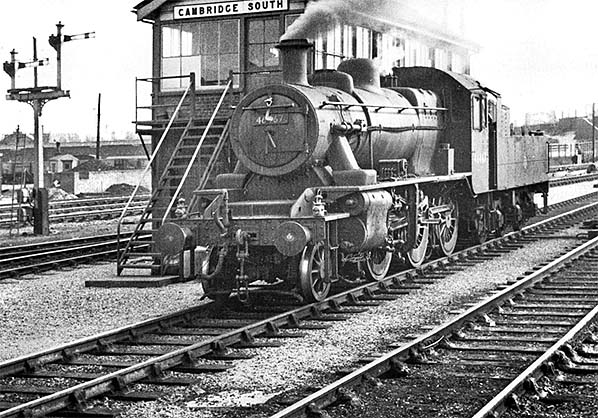 Ivatt 2MT No.46467 saunters past Cambridge South signal box on an unknown date in the 1950s. The tracks in the foreground were, and still are, bi-directional but the general drift of the smoke from the locomotive's chimney suggests she is running smokebox-first. This locomotive was one of three allocated to Cambridge when brand new, the others being 46465/6. They were later joined by others transferred from elsewhere. Kettering, 15B, based examples were also a regular sight at Cambridge as were one or two examples of the BR Standard version. Those allocated to Cambridge were common on the Mildenhall, Stour Valley and Colne Valley lines. The headcode displayed by 46467 is misleading. One lamp each end of the bufferbeam is usually taken as meaning express passenger but it also applied to other types of train. It was also used to signify a station pilot, in which case one red and one white lamp would be displayed each end of the locomotive. It is therefore possible 46467 was on pilot duty when photographed. Station pilot duties often included a trip along a branch or some other local passenger or goods working and the Cambridge pilots were no exception with, for many years, an escape along the Mildenhall branch included. 46467 moved to the Scottish Region in 1961 and survived until 1964. The heavy-gauge piece of wire bridging the rail joint in the foreground was for track circuit continuity. In the right background can be seen the steps leading down from the then-not-yet-rebuilt Hills Road bridge.
Ivatt 2MT No.46467 saunters past Cambridge South signal box on an unknown date in the 1950s. The tracks in the foreground were, and still are, bi-directional but the general drift of the smoke from the locomotive's chimney suggests she is running smokebox-first. This locomotive was one of three allocated to Cambridge when brand new, the others being 46465/6. They were later joined by others transferred from elsewhere. Kettering, 15B, based examples were also a regular sight at Cambridge as were one or two examples of the BR Standard version. Those allocated to Cambridge were common on the Mildenhall, Stour Valley and Colne Valley lines. The headcode displayed by 46467 is misleading. One lamp each end of the bufferbeam is usually taken as meaning express passenger but it also applied to other types of train. It was also used to signify a station pilot, in which case one red and one white lamp would be displayed each end of the locomotive. It is therefore possible 46467 was on pilot duty when photographed. Station pilot duties often included a trip along a branch or some other local passenger or goods working and the Cambridge pilots were no exception with, for many years, an escape along the Mildenhall branch included. 46467 moved to the Scottish Region in 1961 and survived until 1964. The heavy-gauge piece of wire bridging the rail joint in the foreground was for track circuit continuity. In the right background can be seen the steps leading down from the then-not-yet-rebuilt Hills Road bridge.
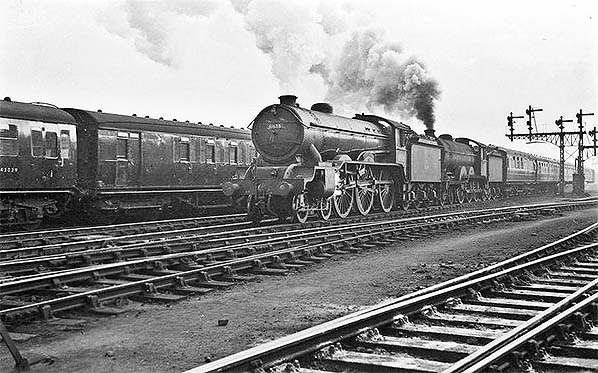 A short double-headed train departs north from Cambridge with B17 No. 61638 'Melton Hall' as pilot locomotive. The suburban train on the left contains a BR non-corridor composite, this type being introduced c.1954. The B17 was withdrawn in March 1958 so the photograph can be dated to the 1954 - 8 period. The second locomotive is an unidentified B12 and judging by the exhaust appears to be having some sort of trouble - poor quality coal perhaps, which might be why the B17 had been attached. The train was thought to be the Hunstanton portion of the down Fenman but there is no buffet car; the leading vehicle appears to be a Gresley brake third. A van has been attached to the rear of the train.
A short double-headed train departs north from Cambridge with B17 No. 61638 'Melton Hall' as pilot locomotive. The suburban train on the left contains a BR non-corridor composite, this type being introduced c.1954. The B17 was withdrawn in March 1958 so the photograph can be dated to the 1954 - 8 period. The second locomotive is an unidentified B12 and judging by the exhaust appears to be having some sort of trouble - poor quality coal perhaps, which might be why the B17 had been attached. The train was thought to be the Hunstanton portion of the down Fenman but there is no buffet car; the leading vehicle appears to be a Gresley brake third. A van has been attached to the rear of the train.
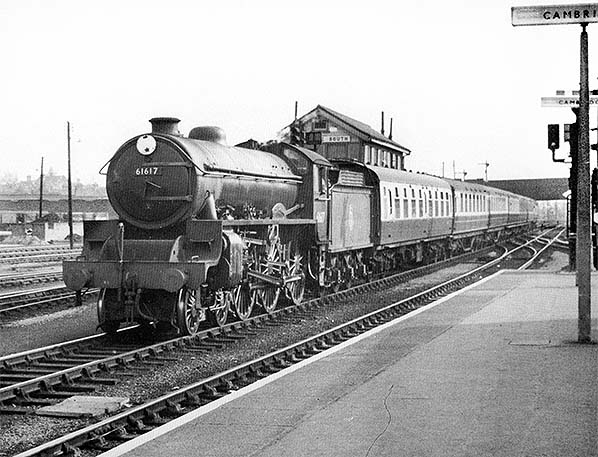 Class B2 No.61617 Ford Castle arrives at Cambridge with a local service from one or other of the London termini. The locomotive is one of those which began life as a Gresley B17 Sandringham and was rebuilt into 2-cylinder form by Edward Thompson. All these rebuilds became Class B2 and ultimately the entire class was based at Cambridge. Some of the class were given ex-North Eastern Railway tenders, 61617 being one of them. Ford Castle carried green livery, being the reserve Royal Train locomotive. The date is between October 1955, by which time fluorescent platform lighting had been installed, and August 1958 when Ford Castle was withdrawn. Note the mix of colour light, lower and upper quadrant signalling.
Class B2 No.61617 Ford Castle arrives at Cambridge with a local service from one or other of the London termini. The locomotive is one of those which began life as a Gresley B17 Sandringham and was rebuilt into 2-cylinder form by Edward Thompson. All these rebuilds became Class B2 and ultimately the entire class was based at Cambridge. Some of the class were given ex-North Eastern Railway tenders, 61617 being one of them. Ford Castle carried green livery, being the reserve Royal Train locomotive. The date is between October 1955, by which time fluorescent platform lighting had been installed, and August 1958 when Ford Castle was withdrawn. Note the mix of colour light, lower and upper quadrant signalling.
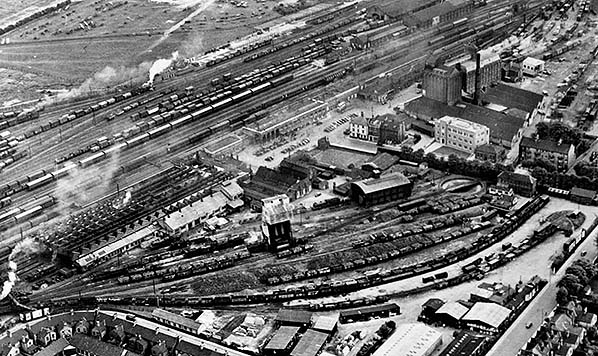
An aerial view of Cambridge station and environs in the mid-1950s and looking south-east. The station building is in the centre of the image with the ex-GER engine shed towards bottom left. Due to the complexity, click here for a higher resolution annotated version
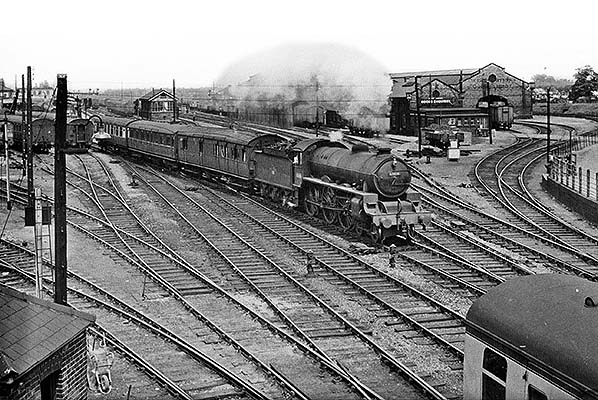 Class B2 No.61616 Fallodon departs southwards from Cambridge with a short, unidentified, local train. The date is not recorded but as the tender carries the post-1956 BR logo and the locomotive was withdrawn in 1959 it is between those dates. The train has departed from platform 3. The locomotive is one of those which began life as a Gresley B17 Sandringham and was rebuilt into 2-cylinder form by Edward Thompson. All these rebuilds became Class B2 and ultimately the entire class was based at Cambridge. Some of the class were given ex-North Eastern Railway tenders, 61616 being one of them. In the right foreground the end of a BR Mk1 carriage can be seen; it will be on the end of a train waiting to be shunted into a station platform.
Class B2 No.61616 Fallodon departs southwards from Cambridge with a short, unidentified, local train. The date is not recorded but as the tender carries the post-1956 BR logo and the locomotive was withdrawn in 1959 it is between those dates. The train has departed from platform 3. The locomotive is one of those which began life as a Gresley B17 Sandringham and was rebuilt into 2-cylinder form by Edward Thompson. All these rebuilds became Class B2 and ultimately the entire class was based at Cambridge. Some of the class were given ex-North Eastern Railway tenders, 61616 being one of them. In the right foreground the end of a BR Mk1 carriage can be seen; it will be on the end of a train waiting to be shunted into a station platform.
 Gresley K3 2-6-0 No.61834 takes water at platform 4 of Cambridge station c1960. The K3s were disliked by fitters, while crews positively detested them on anything other than plodding goods trains. Intended for fast goods trains, the class could also be seen on passenger trains and this is likely to be the case above. The main objection to the class from the crews point of view was their rough riding; the rear end, that is, the cab end, was prone to often-violent syncopatory motions which could and did cause damage to the locomotives over time. Nevertheless the final class members survived in service until the end of 1962 with a few lasting a few more years as stationary boilers. 61834 lasted until May 1962. Note the array of lower quadrant signals with smoke deflector. Cambridge North was rather slow in acquiring colour-light signals whereas by this time a few had been in existence at South for some time. There was three water cranes at this end of the station; the second is partly visible on the left and the third was at the end of platform 6. A fourth existed near the north end of the avoiding lines, hidden here by the maroon Mk1 carriages. In the distance a diesel shunter of what was to become Class 03 is busying itself with a train of goods vans
Gresley K3 2-6-0 No.61834 takes water at platform 4 of Cambridge station c1960. The K3s were disliked by fitters, while crews positively detested them on anything other than plodding goods trains. Intended for fast goods trains, the class could also be seen on passenger trains and this is likely to be the case above. The main objection to the class from the crews point of view was their rough riding; the rear end, that is, the cab end, was prone to often-violent syncopatory motions which could and did cause damage to the locomotives over time. Nevertheless the final class members survived in service until the end of 1962 with a few lasting a few more years as stationary boilers. 61834 lasted until May 1962. Note the array of lower quadrant signals with smoke deflector. Cambridge North was rather slow in acquiring colour-light signals whereas by this time a few had been in existence at South for some time. There was three water cranes at this end of the station; the second is partly visible on the left and the third was at the end of platform 6. A fourth existed near the north end of the avoiding lines, hidden here by the maroon Mk1 carriages. In the distance a diesel shunter of what was to become Class 03 is busying itself with a train of goods vans
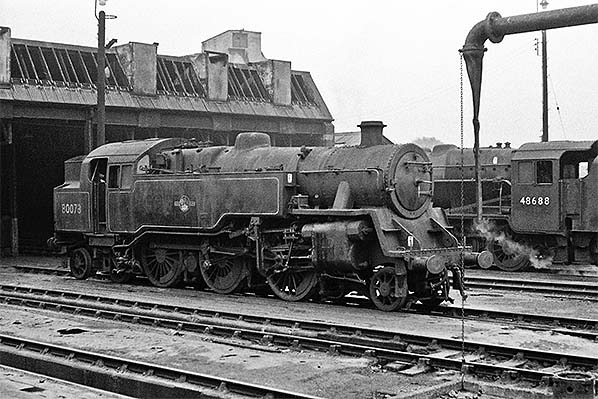
Cambridge shed on 3 November 1962 with a BR Standard 4MT 2-6-4T No. 80073 and an ex-LMS Stanier 8F 2-8-0 present. The closure date of Cambridge shed was officially 18 June 1962 but in practice that date merely saw the shed's allocation either transferred away or withdrawn and the shed itself continued to be used for visiting steam locomotives and for stabling diesel traction. Steam continued to appear at Cambridge, mainly from the Bletchley line, until 1965 and, of course, Cambridge retained some departmental carriage-heating locomotives. 80073 and 80078 had been allocated new to the LT&S section but by the time the above photograph was taken 80078 had been reallocated to Shrewsbury. 80073, on the other hand stayed iun East Anglia and was allocated to March between September and December 1962. Despite its scruffy condition and missing smokebox numberplate it was therefore obviously not withdrawn. These fine locomotives were regular performers on the Cambridge - Bletchley line and were not unknown on stopping and goods services from other lines, including from London. Sadly, like all the BR Standard types, the 4MT tanks did not even see two decades of service. The 8F, obviously in steam, was one of a batch built by the Southern Railway at Brighton during WWII. There was nothing unusual about this as during WWII the Big Four railways all came under the umbrella of the Railway Executive Committee, as did London Transport's railways. In November 1962 48688 was, as might be gathered, a Bletchley locomotive. She survived until July 1965 whereas the newer 4MT lasted only until July 1964. Behind the engine shed the top of the coaling tower can be seen , this structure survived until 1967. The north end of Cambridge station's platform 6 is behind the photographer.
Click here for Gallery 2: June 1964 - May 1977

